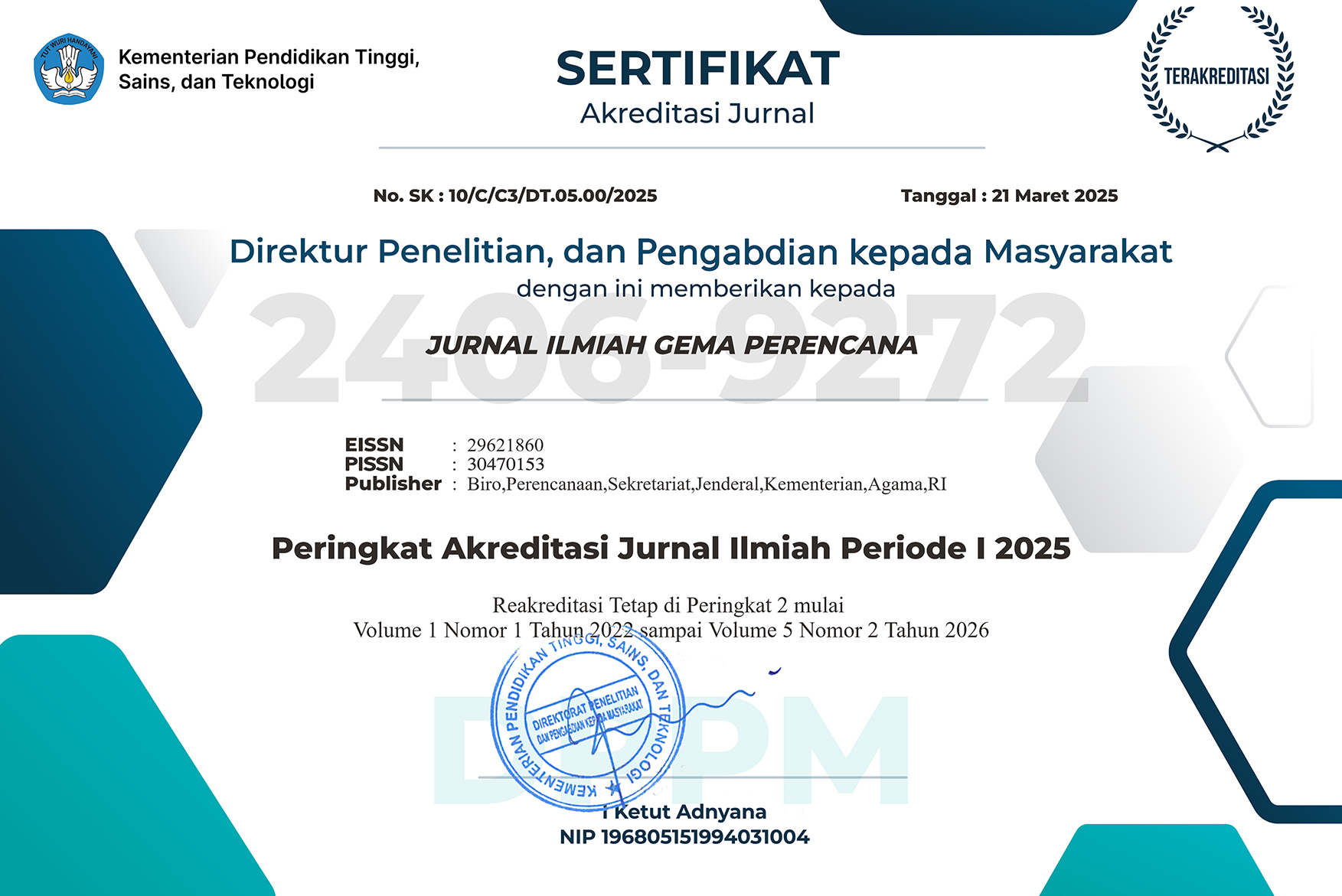The Role of State Islamic Religious Universities in Equalizing Higher Education for the Community in Central Kalimantan
DOI:
https://doi.org/10.61860/jigp.v3i2.150Abstract
Higher education is the main pillar in producing superior, competitive human resources (HR), and able to drive sustainable national development. Conditions that are not yet in harmony occur in Central Kalimantan where the Gross Participation Rate for higher education in 2024 is still relatively low, which is 27.49%. This low Gross Participation Rate reflects the inequality of access to education between urban and rural areas. Factors that cause this low figure include Geographical and Accessibility conditions, Socio-Economic Conditions, Lack of Higher Education Institutions, Culture and Awareness of Education and Lack of Information and Assistance. The problem statement in this Policy Paper is the Socio-Economic Conditions of the community in Central Kalimantan. The writing of this Policy Paper uses a descriptive qualitative method, the data collection techniques used are observation, interviews, and documentation. The results show that the majority of the population of Central Kalimantan works in the informal and agricultural sectors, making income still low and vulnerable to social and economic inequality which has an impact on the low Gross Participation Rate. The policy options offered in this Policy Paper to overcome this problem are by creating technical guidelines for expanding affirmative programs by the Directorate General of Islamic Education, which is expected to be the best solution and policy alternative in resolving the problem of low participation in higher education.
Downloads
References
Afandi, R., & Rocmah, L. I. (2015). Pramuka Sebagai Wadah Mengembangkan Life Skill Mahasiswa Calon Guru Pada Perguruan Tinggi LPTK. Pedagogia : Jurnal Pendidikan, 4(2), 135–140. https://doi.org/10.21070/pedagogia.v4i2.16
Ardhy, A. A. S. (2024). Respons Pendidikan Islam terhadap Radikalisme, Toleransi, dan Pluralisme di Era Kontemporer. Jurnal Ulul Albab, 28(2), 126. https://doi.org/10.31764/jua.v26i2.23560
Bappeda Provinsi Kalteng. (2023). Analisis Disparitas Pendidikan Antarkabupaten.
BPS. (2022a). Profil Kemiskinan dan Pendidikan di Kalimantan Tengah. BPS Kalteng.
BPS. (2022b). Susenas Kalimantan Tengah.
BPS Kalimantan Tengah. (2023). Statistik Kesejahteraan Rakyat 2023.
Dunn, W. N. (2003). Analisa Kebijakan Publik. PT. Prasetia Widia Pratama.
Fadli, F., & Miftah, M. (2023). Kebijakan Cyber Islamic University Dalam Peningkatan Sdm Di Era Society 5.0. Manajemen Pendidikan, 18(2), 141–151. https://doi.org/10.23917/jmp.v18i2.23287
Farman, F., Chairuddin, C., Herlina, H., Marniati, M., Hali, F., & Nasrum, A. (2021). Kkn Tematik: Peningkatan Kualitas Hidup Bersih Dan Sehat Masyarakat Desa Lapao-Pao Kabupaten Kolaka. Jurnal Al Basirah, 1(2), 117–126. https://doi.org/10.58326/jab.v1i2.24
Global Education Monitoring Report 2020: Inclusion and education: All means all. Paris. (2020). In Global Education Monitoring Report 2020: Inclusion and education: All means all. Paris. https://doi.org/10.54676/jjnk6989
Guntoro, D. W., & Sholekhah, I. (2023). SES (Socio-Economis Status) dalam Pengambilan Keputusan Melanjutkan Pendidikan Tinggi di Provinsi Kalimantan Tengah. Neraca: Jurnal Pendidikan Ekonomi, 9(1), 48–54. https://doi.org/10.33084/neraca.v9i1.5787
Humiati, H., & Budiarti, D. (2020). Peran Perguruan Tinggi Dalam Meningkatkan Sumber Daya Manusia. JMM - Jurnal Masyarakat Merdeka, 3(1), 13–24. https://doi.org/10.51213/jmm.v3i1.46
Indonesia Mengajar. (2021). Catatan Lapangan Wilayah Kalimantan Tengah: Tantangan Akses dan Informasi Pendidikan.
Kemendikbudristek. (2021). Pemetaan Minat Lanjut Studi di Daerah 3T.
Kemendikbudristek. (2023). Kajian Sosial Pendidikan Daerah.
Kementerian Pendidikan dan Kebudayaan Republik Indonesia. (2021). Strategi Pengembangan Pendidikan Tinggi di Indonesia.
Kemkominfo. (2022). Survei Indeks Literasi Digital Nasional.
Marginson, S. (2016). Higher education and the common good. Melbourne University Press.
Marlinah, L. (2019). Pentingnya Peran Perguruan Tinggi dalam Mencetak SDM yang Berjiwa Inovator dan Technopreneur Menyongsong Era Society 5.0. Jurnal IKRA-ITH Ekonomika, 2(3), 17–25. http://journals.upi-yai.ac.id/index.php/IKRAITH-EKONOMIKA/article/view/647
Miles, B. M., & Hubern, M. (1992). Analisis Data Kualitatif Buku Sumber Tentang Metode-metode Baru. UIP.
Sari, R. K., Bangapadang, S., & Hidayat, C. (2019). Analisis Peran Perguruan Tinggi Terhadap Bonus Demografi di Indonesia. Hubungan Pengetahuan Ibu Hamil Dan Tingkat Ekonomi Tentang Kejadian Stunting, 3(2), 14–15.
Sugiyono. (2017). Metode Penelitian Kuantitatif, Kualitatif, dan R&D. Bandung. Alfabeta.
Syukron, B. (2016). Implementasi Manajemen Mutu Terpadu (Studi Transformatif Pada Perguruan Tinggi). Jurnal Penelitian, 10(2), 231–252. https://doi.org/10.21043/jupe.v10i2.1783
Trow, M. (1973). Problems in the Transition from Elite to Mass Higher Education. Carnegie Commission on Higher Education.
Downloads
Published
How to Cite
Issue
Section
License
Copyright (c) 2024 JURNAL ILMIAH GEMA PERENCANA

This work is licensed under a Creative Commons Attribution 4.0 International License.









